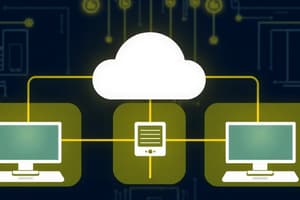Podcast
Questions and Answers
What is the primary purpose of SOAP in web services?
What is the primary purpose of SOAP in web services?
- To serve as a content management system for web services
- To store and manage database connections
- To provide a user interface for web applications
- To enable applications built on different programming languages to communicate (correct)
What are the two main components of a SOAP envelope?
What are the two main components of a SOAP envelope?
- Client and Server
- Header and Footer
- Request and Response
- Header and Body (correct)
Which language is used to describe web services in WSDL?
Which language is used to describe web services in WSDL?
- CSV
- JSON
- HTML
- XML (correct)
What role does UDDI play in web services?
What role does UDDI play in web services?
What does REST stand for in web services?
What does REST stand for in web services?
What is an advantage of using web services?
What is an advantage of using web services?
Which of the following describes a component found in the SOAP header?
Which of the following describes a component found in the SOAP header?
What does a WSDL file provide for a client application?
What does a WSDL file provide for a client application?
What is the primary function of a web service?
What is the primary function of a web service?
Which of the following is NOT a characteristic of a complete web service?
Which of the following is NOT a characteristic of a complete web service?
What is the role of XML in web services?
What is the role of XML in web services?
What does SOAP stand for in the context of web services?
What does SOAP stand for in the context of web services?
What type of messages does XML-RPC use to perform remote procedure calls?
What type of messages does XML-RPC use to perform remote procedure calls?
When a client invokes a web service, what is primarily transferred between the client and server?
When a client invokes a web service, what is primarily transferred between the client and server?
What allows diverse applications to communicate using XML-RPC?
What allows diverse applications to communicate using XML-RPC?
What is the main purpose of remote procedure calls (RPC) in web services?
What is the main purpose of remote procedure calls (RPC) in web services?
Flashcards are hidden until you start studying
Study Notes
Web Service Overview
- Web services enable communication between client and server applications on the internet.
- They provide a unified platform allowing applications built in various programming languages to interact seamlessly.
Characteristics of Web Services
- Accessible over the Internet or private networks (intranets).
- Utilize a standardized XML messaging system for data transfer.
- Not restricted to a single operating system or programming language.
- Self-describing through a common XML grammar.
- Discoverable via simple mechanisms.
Communication Methods
- Requests from clients are called Remote Procedure Calls (RPCs) aimed at specific methods in web services.
- XML is the primary data format for communication between applications, ensuring compatibility across diverse systems.
- SOAP (Simple Object Access Protocol) is used for sending XML data in web service interactions, encapsulated in SOAP messages.
Popular Web Services Protocols
-
XML-RPC:
- A simple protocol using XML for remote procedure calls.
- Requests sent via HTTP POST; responses embedded in HTTP responses.
- Platform-independent and facilitates communication between diverse applications.
-
SOAP:
- Serves as an intermediate language enabling rapid interaction between applications across different programming languages.
- Contains a root element called the
<envelope>, divided into a header (routing data) and body (actual message).
WSDL and UDDI
-
WSDL (Web Services Description Language):
- An XML-based file providing comprehensive details about the functionality of web services and connection requirements.
-
UDDI (Universal Description, Discovery, and Integration):
- A standard for describing and discovering web services provided by service providers.
- Acts as a registry akin to a telephone directory, enabling client applications to locate essential web service information and WSDL files.
REST (Representational State Transfer)
- REST is a lightweight architectural style for building web services, focusing on scalability and maintainability.
Benefits of Web Services
- They expose business functionality over the network, allowing managed code to provide useful features to client applications or end users.
Studying That Suits You
Use AI to generate personalized quizzes and flashcards to suit your learning preferences.




